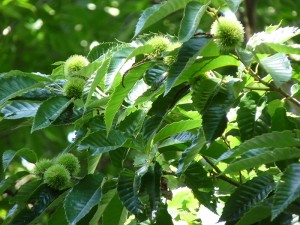The American chestnut was once one of the most abundant trees of the eastern United States. It is estimated that up until the early part of the Twentieth Century thirty percent of the trees in our eastern forests were American chestnuts. It was a tall, although not the tallest, tree in the forest. It was a tree of great, spreading mass with huge trunks ten or twelve feet diameter and thick, extending, shading branches (as in the poem “Under the spreading chestnut tree, the village Smithie stands…”) that covered over remarkably large areas (Photo of virgin American chestnut trees used with permission from the Forest History Society).
The American chestnut also produced large numbers of extremely palatable nuts that were eaten not only by squirrels, birds, deer, and bears but also humans. These nuts were produced in abundance every year (unlike oak trees, say, that make their acorns over multi-year, boom and bust cycles), and many animals relied on this predicable production of chestnuts to sustain their populations.
The wood of the chestnut was strong as oak but lighter and more easily worked. The bark yielded tannins for small scale leathering, and even the leaves were thought to have medicinal value. It was a beautiful shade tree and was widely preserved and planted in the growing towns and cities throughout America.
In 1904, though, the American chestnuts lining the roads and walkways of the Bronx Zoo began to sicken. Their leaves withered and great lesions appeared in their bark. The trees then died one by one. They were the first recorded casualties of Chestnut Blight epidemic that swept through the eastern United States. There is evidence that the fungus responsible for this disease had been present in the southern U.S. since the 1820’s, but the death of the chestnuts in New York set off alarms that reverberated through the country. By 1950, the American chestnut was for all intents and purposes “gone.” It was no longer a reliable source of nuts or timber. It was no longer a tree of size and majesty.
The species, though, persisted even in the face of this awful disease. The fungus is transported either via insects or on the wind and infects a tree through cracks in its bark. The fungal mycelia then grow into the cambium layer of the tree (the part of the tree’s vascular system that transports sugars and nutrients). The tree responds to the infection by sealing off the infected cambium with a dense callus tissue, but the fungus grows faster than the callus and eventually the tree loses its ability to transport nutrients and dies. The fungus, though, does not affect the tree’s roots. New chestnut trees are thus able to sprout from the still living roots and stumps. Depending upon the site density of the chestnut trees and the abundance of the fungal spores, these new sprouts may grow for ten to fifteen years before the fungal infection kills them. They can reach heights of fifteen to twenty feet and can even produce nuts for several years before they die back. This growth and die-back cycle has caused the American chestnut to become more of a tall shrub than a tree!
Out in my yard and field I have had a small number of American chestnuts scattered among the oak, maple, apple, crab apple, locust, and spruce trees. Several of these trees have gone through cycles of growth and die-back in the 25 years I have lived here. Three trees, though, clustered into a corner of my field have lasted more than twenty years and to date have shown no sign of the fungus. They have grown to heights of 30 to 35 feet and last year produced an abundance of chestnuts in their spiky encasing burrs. I had to fight the squirrels for my share.
There are two associations that are working hard to develop a blight resistant American chestnut tree. The American Chestnut Foundation (which includes Penn State) and The American Chestnut Research and Restoration Center (which is based at one of my alma maters, The State University of New York College of Environmental Science and Forestry). Through incredible time and effort the scientists of these groups are now very close to developing American chestnut tree strains that are not affected by the blight. The thought that we might soon be able to re-establish these magnificent (and ecologically significant) trees throughout our eastern forests is one of the most hopeful and exhilarating pieces of environmental news that I have heard in decades.
For us here in Western Pennsylvania the nearby Chestnut Ridge might one day live up to its historical name! Let’s hope that our grandchildren will someday see it covered once again with American chestnut trees!



